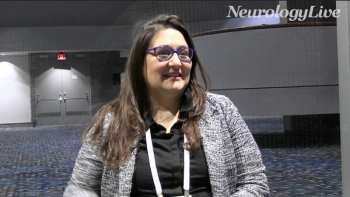
Reactivating Muscle Stem Cells in DMD: The Science Behind SAT-3247
Phil Lambert, PhD, chief scientific officer at Satellos Bioscience, discusses the rationale and early clinical progress of SAT-3247, a novel regenerative therapy targeting muscle stem cells in Duchenne muscular dystrophy.
The Duchenne muscular dystrophy (DMD) treatment landscape has progressed from supportive care and steroids to targeted therapies like exon-skipping drugs and gene therapies. Recent advances have aimed to restore dystrophin production and slow disease progression, marking a shift toward more personalized and disease-modifying approaches.
Several therapeutics were on display at the
During the meeting, NeurologyLive® sat down with Phil Lambert, PhD, chief scientific officer at Satellos, who discussed the scientific rationale and phase 1 data behind SAT-3247. He outlined how the company is taking a novel approach by targeting the muscle stem cell’s ability to regenerate muscle–specifically through AAK1 inhibition to restore dystrophin-like signaling. In the interview, Lambert reviewed the completed SAD and MAD portions of the study, as well as shed light on plans for a phase 2 program and future combination strategies.
Discuss the rationale behind SAT-3247—why do we believe it can be successful in treating DMD?
Phil Lambert, PhD: Satellos Bioscience has been working extremely hard to come up with a treatment for DMD, and we are focused—maybe a good way to start thinking about the drug is to first understand how we think about DMD. We've been approaching it a little differently due to a finding from our founder’s lab. Michael Rudnicki, at the University of Ottawa—our scientific founder—discovered a very significant role of dystrophin in the stem cell, not just in the muscle fiber. That set us up to think about DMD as a disease of failed muscle regeneration.
These stem cells that lack dystrophin aren’t capable of efficiently making progenitor cells to generate new muscle. And considering how difficult it would be to replace dystrophin in those specific stem cell niches, we aimed to come up with a small molecule that would act on the stem cell and replace the signaling function of dystrophin. We're not putting dystrophin itself back, but we are restoring the necessary signaling component of the cell. So when the stem cell is triggered by an injury signal, it's now able to respond much more efficiently—again, not by restoring dystrophin, but by allowing the cell to function more like it would if it had dystrophin.
Over time, patients with DMD lose muscle—not because they never had it, but because they can't regenerate it fast enough. They start off with functional muscle and can walk, but over time, their regenerative capacity diminishes. In a healthy individual, damaged muscle regenerates. In DMD, that process is impaired. We believe SAT-3247 can restore that regenerative potential.
We launched a large screening campaign to identify appropriate targets that could replace that dystrophin signaling in the stem cell. We landed on AAK1 as a very important target. If you inhibit AAK1, the stem cell is then able to respond to injury by undergoing asymmetric division—producing a progenitor cell to regenerate muscle and another stem cell to replenish the pool. That’s the fundamental mechanism we’re targeting.
This is a very different approach—an idea that for a long time came out of left field. Michael and the team at Satellos have been working on it since 2018. About two and a half to three years ago, we began putting drugs up against AAK1. We have a lot of preclinical animal data showing that our drug can not only regenerate muscle but also lead to added muscular function. The next step was getting ourselves in a position to produce a safe drug to test in people—to test the theory.
We screened a number of compounds—novel chemical entities, our own Satellos molecules that are highly selective and potent AAK1 inhibitors. SAT-3247 was selected for several reasons as our clinical candidate. It’s gone through a lot of preclinical testing, and now we’ve advanced to the clinical program. As you know, that’s what I’m here to present.
How was the phase 1 study conducted and what were the major takeaways?
We’ve run a fairly standard phase 1 study with SAD (single ascending dose) and MAD (multiple ascending dose) cohorts. We did escalating single doses of SAT-3247, followed by escalating seven-day dosing. It was very much focused on safety and pharmacokinetics (PK)—how the drug is handled in people compared to animals, and whether we could reach the exposure levels needed for efficacy.
Several findings came out of the study. First, the compound was extremely safe at all doses. That gives us the window we need for dosing above what we believe are efficacious levels. Any changes observed in healthy volunteers were consistent with what we saw in animal models and were easily monitored—not adverse.
On the PK side, there were several things that excited us. One, the handling of the drug in people was very dose-related and predictable. At doses we think will be efficacious, there was no accumulation with repeated dosing—it looked much the same after single and multiple doses. That’s important from a toxicity standpoint and from a target-coverage perspective for efficacy.
Also, the scaling from animals to humans held up very well. We were able to confirm that the exposure levels we expected were achieved. That was a key moment of validation. Another really important point is that SAT-3247 is orally available. DMD patients often struggle to travel to clinical sites or tolerate invasive therapies. This is a small molecule in pill form, which is a huge advantage. Based on our dose scaling, we manufactured tablets of specific strengths, and those have aligned well with our clinical needs—meaning we don’t need to go back and redo CMC work at this stage.
There’s one last point I want to touch on. We were able to extend the phase 1 study in Australia to include up to 10 adult patients with DMD. The primary goal here is again safety and PK—making sure the drug behaves the same way in patients as in healthy volunteers. It’s a 28-day dosing study. These patients have been kind enough to participate without undergoing invasive procedures like biopsies, but we are collecting some additional endpoints. We're not making any efficacy claims from a 28-day dosing period, but this will be our first look at how SAT-3247 performs in actual patients with DMD. Those data should be ready by the second quarter.
Assuming the cohort of patients with DMD is successful, what would be the next steps in advancing this therapeutic?
It’s still early, so I can’t say exactly what that will look like, but everything from Phase 1 is supporting our path forward. We’re also wrapping up our preclinical safety and toxicity studies to support regulatory filings, and we’re having some good dialogue with agencies about what comes next. We’re excited to share more as things solidify.
And one final thing to add—regarding other treatments in this space. While we are moving forward with SAT-3247 as a standalone therapy, we haven’t ruled out the possibility of combination approaches. DMD is multifactorial, and it’s likely going to take multiple interventions to truly help patients. We believe our drug could work alongside others addressing different aspects of the disease.
It’s also important to remember that DMD is a very heterogeneous condition. You have young children just beginning to lose function and adults in their twenties who’ve lost significant muscle strength. For later-stage patients, slowing progression may not be enough—they may need something that can help regain function. We hope SAT-3247 can be part of that solution. Our team is committed to making a meaningful difference, and we’re excited to keep pushing forward with that goal.
REFERENCE
1. Dubow J. First-in-human Phase 1 study of orally administered SAT-3247 in healthy volunteers and adult participants with Duchenne Muscular Dystrophy (DMD). Presented at: 2025 MDA Clinical & Scientific conference. March 16-19. Dallas, TX. ABSTRACT O98.
Newsletter
Keep your finger on the pulse of neurology—subscribe to NeurologyLive for expert interviews, new data, and breakthrough treatment updates.































